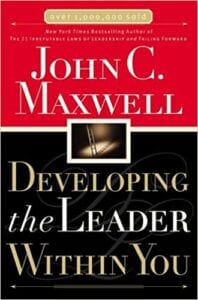
A team is built with a leader setting a goal, but it can only move towards that if every member works at their best. Jeffrey Edwards discusses the proper way to do work delegation, an important factor in every top-performing business. He explains how being clear with your goals and building relationships with your team are always excellent steps in delegating tasks and improving work processes. Jeffrey also emphasizes why a business must never be about making multiple clones of yourself but inspiring people to step up and lead themselves.
—
Listen to the podcast here:
Improving Your Team With Proper Work Delegation
This topic is on delegation. Where I’d find delegation is simply how do you maximize the people around you. How do you maximize your time and resources around you that allow for you and the people around you and your organization as a whole to achieve its peak performance? Author John Maxwell is a recognized Speaker, Author, Trainer, Coach. In his book, Developing The Leaders Around You, he has this quote. “If you want to do the small things right, do them yourself. If you want to do great things and make a big impact, learn to delegate.”
Let’s go through the benefits of delegation. First, how nice would it be to know that you don’t have to do everything? You sit down and you get to your desk in the morning. You can spend time sitting down and require more strategic focus to be able to think, be creative, and then consult. Take that time to look at the possibilities and at the bigger picture versus feeling constant. You’re spending a majority of your time on the everyday tactical detail-oriented information.
That doesn’t allow you the time or the breath with the scope to look beyond, look at your team and how you can move people forward. When it comes to being a leader, one of the tenets of leading is to help other people. Now it becomes less about you and it’s more about how do we go from that transition from the me to the we. When you’re looking at the we, what do you need? What time do you need? What space do you need both physically, mentally time-wise to allow you to spend time to focus on your team or your organization in a way that allows you to focus on growth, improvement, innovation and performance improvement?
Letting go means permitting people to explore, be creative, be innovative, and build their own strategies. Share on XIt’s easy to secure it. It’s easy to say, “I’m in.” You can even say, “This delegation thing, I’m warming up to it. What do I do next?” I organize myself in a way that can allow me to actually do this effectively. Let’s walk through it. There are five steps that you can look at that can help you to start to organize yourself, how you can present yourself, get ready so that you can be that delegator and be the person that is looking at the longer-term.
Let’s look at what are the benefits of delegation. Let’s take a look at this from three levels. Let’s look at it from a personal perspective. It’s giving you the opportunity to look at how you make full use of the talents, experiences and skills of the people who report to you or the people in your organization? What can they do that may be a benefit to you that A) you may not have the time to get to or B) it may be something that others in your organization can do that much better? You can now assign those tasks and the responsibilities over time to people who are eager, who are enthusiastic and want to do the work and do it well.
Another benefit B is recognizing talent. Think of a time in your career where someone came up to you and say, “I had this project I feel that you’re a great fit for and I want you to lead it.” What will be that feeling you’d have? You might have that initial feeling of, “Why me?” That’s a whole other story. They’re picking you for a reason. A) they either saw your interests and what you can do. They can look at it from the point of view as “You’ve got the skills. You’re a key performer on this team. Giving this assignment to you can be beneficial to you as you go for your career.”
You’re doing that. You’re giving someone an opportunity to do that and giving them that recognition. How did it feel for you at any point in time when someone came up to you and say, “I want you to take this on because I believe you can? I know you have the skills and the experience. You may have the background and I feel that it’s time.” How did it feel for you when that happened? How would it feel to know the people on your team, the people that report to you and the people that you work with? That recognition alone, you’re creating a new dialogue and a new level of relationship with that person.
By doing so, you’re inspiring their performance. You’re recognizing what they have done. The key message on the other side in what you’re doing is A) someone recognizes me. I’m being seen. Someone appreciates what I am doing. This person has some trust in me to take this on. What would it mean to have an environment to create a culture where everyone felt that way about you, the team and the environment in which they work? They know that they are seen and that they are valued. Their skills or contributions are being recognized and you are willing to delegate. Challenge them and give them the opportunity to grow.
If we look at those benefits on our own, if you think about it from an individual perspective, your perspective, a team member’s perspective or an organizational perspective to see the cascading effect and the impact it can have, why wouldn’t you want to create that? If you’re feeling okay, I’m buying into the delegation bit. For many years it’s, “How do I determine and what do I give? How do I assign these tasks? What should I do?” There is a bit of hesitancy and that’s okay.
Do not create a clone of yourself when delegating work. Instead, listen to them and monitor what they are doing. Share on XThe first step in delegation is checking in with yourself. It’s looking at how well do you know everything that you do on a regular basis. One of the areas I’ve seen in working with leaders is the struggle they have in delegating tasks. They don’t have a clear idea of what it is that they do every day. There are things they work on every day, they go to their desk and they go through the routine. It’s to have a clear understanding. If you were to sit down and map out a spreadsheet of all the tasks and responsibilities, committees, reports, projects that you have to complete on a regular basis, what would that look like?
What is that you do? When you look at that list and create that list for yourself, there will be activities. The next time you take a look at those activities and categorize them, how many of those would you say would be strategic in nature? Strategic meaning that they are focusing on the bigger picture. They’re organizational initiatives that you are a part of. Activities that are built in to help develop your team or your department to move forward in terms of innovation or process improvement, wherever that may be, as examples. How many of those activities would be tactical in nature where your day-to-day details reporting could be running regular check-in meetings and such? How many of those are you doing each day?
By doing that, you’re now breaking it down into smaller chunks. When you take a look at that board, how much of your time is spent on strategic activities versus tactical activities? How much time are you spending overall in your day and your week to try and get all of that done? If you’re like many leaders who’ve reported this over the years, you will find that likely you’re spending more time on the tactical and less on the strategic. When you take a look at this list, the next step you say, “Who can I look at to take over some of the tasks that can be done by other people? Proper support, guidance and instruction. That’s a start.”
The next step is to look at your team. How well do you know the team or the people in your organization that could take on the task? Not only the task but to take on the responsibilities associated. To take on the tasks and the responsibilities over time from what you were doing now onto theirs. This requires a little more in-depth. It’s looking at the people around you. What are their skillsets? The questions to ask are what are their skills? What’s their capacity right now? Is it something that they can do at this point or maybe it’s something that may not be right?

Work Delegation: Part of the struggle in delegating tasks is not having a clear idea of your daily work.
Are there people within your organization or team that need to be challenged or looking at something the next level of activity for them to do? Who are your top performers on whatever you assigned to them? Step one, looking at your own work activity. Step two is recognizing who are the people in your team that would be possible candidates to have that delegation conversation. Step three is having that delegation conversation where you’re sitting down and talking about the assignments or tasks you’re going to be handing over to them. You start to have that conversation with them.
In that conversation, you’re sitting down. It’s a dialogue. The first part of that is recognition. You recognize the why. It’s important to understand the why. If they understand the why then the rest will follow. When you look at it, you get to sit down and tell them, “This is what I’m thinking of and why I chose you.” From there, you speak about what it is and what it isn’t. You’re looking at the timeframes and what’s to be expected of them in terms of the performance, quality, the timeframe associated with what the task is and the work that you’re looking to assign to them. The question that leaders tend to struggle with is the how. This is how I do it.
In the course of that conversation, the leader will move forward on how things get done, what the expectations are, what the quality of the work is to do and what the expected quality is going to be. When it comes to the how it becomes a question of embedding trust in their approach. The idea is not to create a clone of yourself. You’re checking in with them. You’re listening to what they’re doing. You’re monitoring progress. You are the coach. Having that dialogue, you’re there to support them in their development in a way that allows them to own it. You’re giving them that freedom to do that as tempting as it may be to want to pull back when things aren’t going exactly as you would like to see them.
Let’s look at some of the barriers to delegation. For some, it’s a release of control. You’re not used to it. Think of the transition from individual performer to now a leader. It’s the mind shift. How do you let go of the notion that you’re being evaluated on what you do? As an individual performer, you are. You did it so well that people recognized you for what you did. Now they say, “We want you to do leadership. We want you to lead other people and help them be excellent in their individual performance.” You’re transitioning from the me to we, where now it’s not about you. It’s about helping others grow. How comfortable are you with that? That also means that you don’t have control over everything on how people approach things. Part of it is letting go. How ready are you to let go?
Leading others is not about you. It’s about helping others grow. Share on XI had a conversation with someone and in our conversation, he was talking about the freedom that he had when he went on vacation. He’s seen that increase over time. The comment that he made was, “The more that I’ve let go of the things I used to do, the more productive I’ve been in other areas of my life, both personally and professionally.” By letting go means that you’re giving people permission to explore, for them to be creative, innovative, to create their own strategies and initiatives and create that safe space for them to ask questions and test their ideas. Knowing full well that they have your support and you will be there to coach or to mentor, whatever that relationship may be.
They’re not in this alone. You’re giving them room to create. You’re helping them find their way as you’re developing your people. What you’ve done up to this point is you’ve looked at all the work activities you have going on. The second part is you’re taking a look at your team and the people in your organization. You’re identifying the key talent and the key people that would be in consideration for delegating assignments or new activities.
You’re identifying key people to whom you can delegate some of your work to and for them to take on those responsibilities based on their skills, talents, experience and also their capacity as well. The third part is sitting down, having that conversation, letting them know that, setting the standard, giving a clear understanding of the criteria that are expected and the level of performance that is going to be measured. At the same time, you’re giving them license to create an approach that works best for them and supporting them through coaching, mentoring and being a sounding board for ideas and experience.

Work Delegation: Delegate work correctly and you can create a safe space for people to ask questions and test their ideas, knowing that they have your full support.
If we take a look at delegation as a whole, what are the skills as well as opportunities that every organization has that allows you to grow and develop your people from within? It’s a wonderful supplement to additional external training and courses that you may bring in to develop teams and organizations. What does it say is it gives people the opportunity to apply what they learn. In doing so, overall, you are taking on delegation, if you’re using this and being mindful of the opportunities around you. You’re starting now to build your leadership bench. You’re now setting the path for future leaders in your organization. Because one day, you’re going to move on and who’s going to be the one sitting in your chair following your legacy and helping others in the same way that you helped them?
I’d like to announce that we have a Facebook page for The Leader’s Chair where we’ll post snippets of the show, mention some of the resources and highlight our guests that have been on the show as well. It’s an opportunity for you to post comments and your questions. We’re going to be doing a lot more using our Facebook page. We look forward to getting your input wherever you may be around the world. Thank you for reading, comments and interests. It’s wonderful to be doing this and seeing how many people out there. I and my team look forward to continuing to grow, provide you with the resources and the people and the information that will help you on your leadership journey.
If this is your first time reading, thank you so much. You can go to Apple Podcasts or Spotify or wherever you listen to your podcasts and give us a five rating. We would appreciate that. Please share this show with the people in your group. Let them know that there’s someone out there looking out for them. If you find this useful then we encourage you to go and share it with the people that you know will benefit from this experience and this information as well. That takes us to the end of the show. We look forward to next time. Until then, remember, be good and lead well.
Important Links:
- Developing The Leaders Around You
- Facebook – The Leader’s Chair
- Apple Podcasts – The Leader’s Chair
- Spotify – The Leader’s Chair
Love the show? Subscribe, rate, review, and share!
Join The Leader’s Chair Community today:






